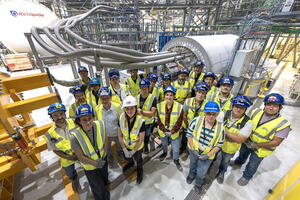Let there be cold
There comes a day when design engineers turn into real operators. For Alessandra Iannetti, who manages the cryopump test facility, for Robert Pearce, who has been involved with cryopump design and engineering for more than three decades, and for the cryopump team that day happened on 1 August. Following months of tests and calibration, the pre-production cryopump inside the facility’s vacuum chamber was cooled down to ~5 K (approximately minus 268 °C, or the temperature of the intergalactic void), gases were injected to simulate plasma operation, and the pumping process started.
Once all mechanical connections with the cryolines were established, pumping was tested with helium (the fusion “waste product”) and neon, which has a similar pumping curve to the fusion fuels deuterium and tritium. This marked the last step of a commissioning process that had begun in January. “Performance was even better than we expected,” says Iannetti. “The cryogenics and vacuum teams coordinated seamlessly, and this was a key factor in this historical achievement.”
Cryopumps condense gas molecules on very cold surfaces, thus achieving levels of vacuum that are impossible to attain with conventional mechanical pumps. The simple physics principle behind their action—called “sorption,” which describes how a molecule or atom slows down to near immobility when it encounters an extremely cold, porous surface—requires highly sophisticated technologies to implement, as well as a touch of unexpected natural ingredients: the pumps’ cryopanels are coated with coconut charcoal, whose porous structure is more effective than synthetic alternatives in capturing helium at ultra-low temperatures.
In ITER, six torus cryopumps are tasked with a double mission: perfecting the high vacuum required in the plasma chamber prior to operation, and evacuating helium ash, unburnt fuel and all exhaust gases during plasma shots. Another two cryopumps will be installed on the cryostat to provide the vacuum that thermally insulates the magnet system from the environment. Procured by Europe, all eight cryopumps have now been delivered.
“We now need to make sure that the production cryopumps behave as the pre-production one has,” says Iannetti. Because the cryoplant will also serve the magnet cold test facility presently under construction, slots for testing cryopumps will be limited to two per year in the coming years, beginning in February 2026. This should be enough to test at least four cryopumps before they are installed in the machine.
“What we have learned so far from technical results as well as operational coordination and management has provide plenty of precious lessons and given us confidence in our approach to the next phases of the ITER project,” she concludes.


